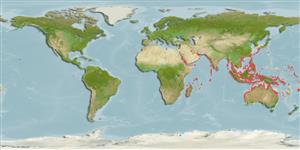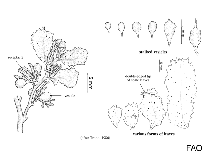Sargassum oligocystum Montagne, 1845
Flat-stemmed sargassum| Native range | All suitable habitat | Point map | Year 2050 |

|
| This map was computer-generated and has not yet been reviewed. |
| Sargassum oligocystum AquaMaps Data sources: GBIF OBIS |
Envoyez vos Photos
Images Google | No image available for this species;
drawing shows typical species in Sargassaceae.
Images Google | No image available for this species;
drawing shows typical species in Sargassaceae.
Classification / Names Common names | Synonyms | CoL | ITIS | WoRMS
| Fucales | Sargassaceae
Environment: milieu / climate zone / depth range / distribution range Écologie
. Tropical
Distribution Pays | Zones FAO | Écosystèmes | Occurrences | Introductions
Indian Ocean: from the Arabian Sea, including the Persian Gulf and the Red Sea south to Mauritius, east to India; in the Bay of Bengal, south to Dampier Archipelago, Western Australia, including Andaman and Nicobar Islands; Pacific Ocean: from China going to the South China Sea, south to Queensland, Australia, east to the Samoan Archipelago, including New Caledonia, Solomon Islands and Republic of Palau.
Length at first maturity / Taille / Poids / Âge
Maturity: Lm ? range ? - ? cm
Description synthétique Morphologie
Holdfast small, discoid; stem short, about 5 mm long, cylindrical to slightly compressed, brownish, finely villose, simple or sometimes branched. Primary branches smooth and strongly flattened, especially at basal portions, 3 to 4 mm at broadest portions. Secondary laterals distichous, alternately arranged along primary branches, up to 18 cm long. Leaves of vegetative materials large, linear-lanceolate, up to 7 cm long, 1.2 cm wide, with very short stalks; those of fertile materials much smaller and reduced, especially toward apical portions, linear to linear-lanceolate. Base of leaves acute to cuneate; margin irregularly serrate-dentate; apex mainly obtuse to acute, those of the smaller leaves mainly acute; midrib distinct almost up to apex. Cryptostomata slightly elevated and scattered on blade, those on small leaves at terminal branches with tendency to form rows along both sides of midrib; those on female receptacles more numerous and distinctly elevated, giving the receptacles a lumpy appearance. Vegetative plants with larger vesicles, 1 to 5 mm wide; those of fertile materials smaller and variable in size, the larger ones 4 to 5 mm long and 2 to 3 mm wide, smaller ones 1.5 mm long and 1 mm wide; most vesicles with cylindrical stalks, mainly 1 mm long, those on female plants longer (up to 4 mm) and stalks flattened; apices of vesicles mainly plain or occasionally with teeth or spines. Plants dioecious. Male receptacles paniculate; receptacular branches up to 3 times unequally dichotomously branched, branches terete but highly warty. Female receptacles form dense cymes; receptacular branches simple or shortly branched, almost of same length, apices slightly compressed, margins and tips with few teeth or spines.
Primary branches up to 80 cm in length (Ref. 80758).
Important source of alginate mainly used as emulsifying, stabilizing and gelling agents in food products; contains iodine, protein, vitamin C, and minerals such as Ca, K, Mg, Na, Cu,Zn, S, P, Mn; used as medicine: goiter, glandular troubles, antibacterial, antitumor; source of tannins and phenols; also
used for animal feed and fertilizer (Ref. 80758).
Life cycle and mating behavior Maturité | Reproduction | Frai | Œufs | Fécondité | Larves
Référence principale
Références | Coordinateur | Collaborateurs
Guiry, M.D. and G.M. Guiry. 2009. (Ref. 80701)
Statut dans la liste rouge de l'IUCN (Ref. 130435)
statut CITES (Ref. 108899)
Not Evaluated
CMS (Ref. 116361)
Not Evaluated
Menace pour l'homme
Harmless (Ref. 80758)
Utilisations par l'homme
Pêcheries: commercial
| FishSource |
Outils
Plus d'informations
Pays
Zones FAO
Écosystèmes
Occurrences
Introductions
Stocks
Écologie
Régime alimentaire
Éléments du régime alimentaire
Zones FAO
Écosystèmes
Occurrences
Introductions
Stocks
Écologie
Régime alimentaire
Éléments du régime alimentaire
Sources Internet
BHL | BOLD Systems | CISTI | DiscoverLife | FAO(Publication : search) | Fishipedia | GenBank (genome, nucleotide) | GloBI | Gomexsi | Google Books | Google Scholar | Google | PubMed | AlgaeBase | Arbre de Vie | Wikipedia (Go, chercher) | Zoological Record



